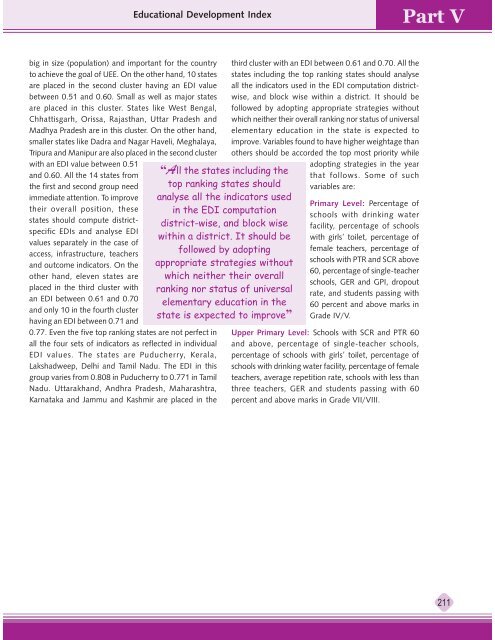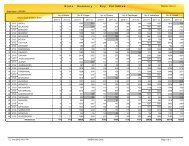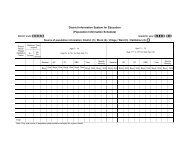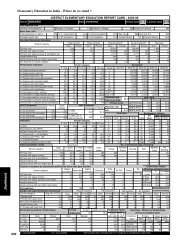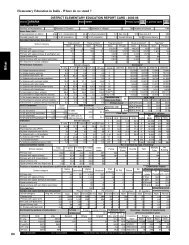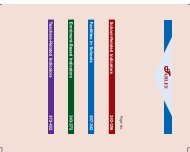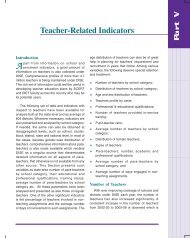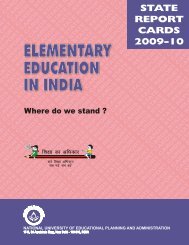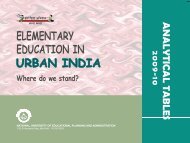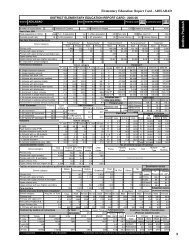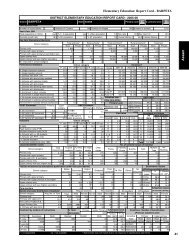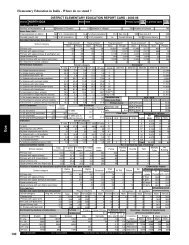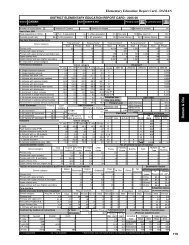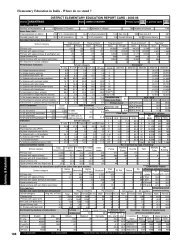Teacher Related Indicators & EDI - DISE
Teacher Related Indicators & EDI - DISE
Teacher Related Indicators & EDI - DISE
You also want an ePaper? Increase the reach of your titles
YUMPU automatically turns print PDFs into web optimized ePapers that Google loves.
Educational Development Index<br />
Part V<br />
big in size (population) and important for the country<br />
to achieve the goal of UEE. On the other hand, 10 states<br />
are placed in the second cluster having an <strong>EDI</strong> value<br />
between 0.51 and 0.60. Small as well as major states<br />
are placed in this cluster. States like West Bengal,<br />
Chhattisgarh, Orissa, Rajasthan, Uttar Pradesh and<br />
Madhya Pradesh are in this cluster. On the other hand,<br />
smaller states like Dadra and Nagar Haveli, Meghalaya,<br />
Tripura and Manipur are also placed in the second cluster<br />
with an <strong>EDI</strong> value between 0.51<br />
and 0.60. All the 14 states from<br />
the first and second group need<br />
immediate attention. To improve<br />
their overall position, these<br />
states should compute districtspecific<br />
<strong>EDI</strong>s and analyse <strong>EDI</strong><br />
values separately in the case of<br />
access, infrastructure, teachers<br />
and outcome indicators. On the<br />
other hand, eleven states are<br />
placed in the third cluster with<br />
an <strong>EDI</strong> between 0.61 and 0.70<br />
and only 10 in the fourth cluster<br />
having an <strong>EDI</strong> between 0.71 and<br />
0.77. Even the five top ranking states are not perfect in<br />
all the four sets of indicators as reflected in individual<br />
<strong>EDI</strong> values. The states are Puducherry, Kerala,<br />
Lakshadweep, Delhi and Tamil Nadu. The <strong>EDI</strong> in this<br />
group varies from 0.808 in Puducherry to 0.771 in Tamil<br />
Nadu. Uttarakhand, Andhra Pradesh, Maharashtra,<br />
Karnataka and Jammu and Kashmir are placed in the<br />
“All the states including the<br />
top ranking states should<br />
analyse all the indicators used<br />
in the <strong>EDI</strong> computation<br />
district-wise, and block wise<br />
within a district. It should be<br />
followed by adopting<br />
appropriate strategies without<br />
which neither their overall<br />
ranking nor status of universal<br />
elementary education in the<br />
state is expected to improve”<br />
third cluster with an <strong>EDI</strong> between 0.61 and 0.70. All the<br />
states including the top ranking states should analyse<br />
all the indicators used in the <strong>EDI</strong> computation districtwise,<br />
and block wise within a district. It should be<br />
followed by adopting appropriate strategies without<br />
which neither their overall ranking nor status of universal<br />
elementary education in the state is expected to<br />
improve. Variables found to have higher weightage than<br />
others should be accorded the top most priority while<br />
adopting strategies in the year<br />
that follows. Some of such<br />
variables are:<br />
Primary Level: Percentage of<br />
schools with drinking water<br />
facility, percentage of schools<br />
with girls’ toilet, percentage of<br />
female teachers, percentage of<br />
schools with PTR and SCR above<br />
60, percentage of single-teacher<br />
schools, GER and GPI, dropout<br />
rate, and students passing with<br />
60 percent and above marks in<br />
Grade IV/V.<br />
Upper Primary Level: Schools with SCR and PTR 60<br />
and above, percentage of single-teacher schools,<br />
percentage of schools with girls’ toilet, percentage of<br />
schools with drinking water facility, percentage of female<br />
teachers, average repetition rate, schools with less than<br />
three teachers, GER and students passing with 60<br />
percent and above marks in Grade VII/VIII.<br />
211


